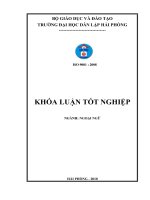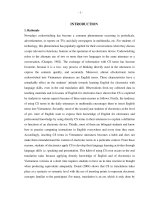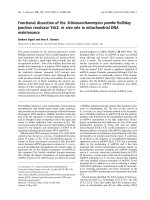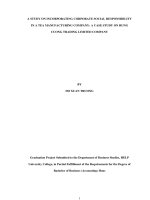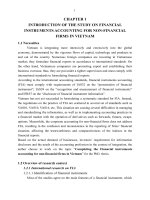Results of the study on Naja siamensis antivenom purification in Vietnam and an assessment of safety and effective test in vitro and in vivo
Bạn đang xem bản rút gọn của tài liệu. Xem và tải ngay bản đầy đủ của tài liệu tại đây (120.27 KB, 9 trang )
Journal of military pharmaco-medicine n06-2018
RESULTS OF THE STUDY ON Naja siamensis ANTIVENOM
PURIFICATION IN VIETNAM AND AN ASSESSMENT OF
SAFETY AND EFFECTIVE TESTS IN VITRO AND IN VIVO
Le Khac Quyen*; Hoang Anh Tuan**; Thai Danh Tuyen***; Trinh Xuan Kiem**
SUMMARY
Objectives: To study Naja siamensis antivenom purification and assess safety and effective
tests in vitro and in vivo. Methods: The study established a protocol for purification of F(ab’)2
Naja siamensis antivenom by using pepsin enzyme to cut Fc of IgG Naja siamensis horse
antibody and removing complements and non-antibody components. Safety and efficacy tests
were performed according to medium lethal dose (LD50) and medium effective dose (ED50).
Results: This study produced successfully liquid and lyophilized Naja siamensis antivenoms
accroding to Vietnamese National standardizations and WHO recommendations. An assessment of
Naja siamensis antivenom in vitro and in vivo showed high safety and strong efficacy.
Conclusion: The study on Naja siamensis antivenom F(ab')2 purification is successful. We hope that the
study will spread out the trend of antidote treatment for Naja siamensis envenomed patients in future.
* Keywords: Naja siamensis antivenom; Safety; Efficacy.
INTRODUCTION
In 2009, World Health Organization (WHO)
classified snake bites as neglected tropical
disease and reconfirmed that venomous
snake antivenom is an antidote only of the
treatment for envenomed patients by snake
venom [9, 10]. Unavailable of specific
antivenoms to treat the envenoming patients
due to many venomous snake species in
different areas in the world becomes a
seriously medical important problem in
the world [10].
From 1894, Dr. Calmette successfully
researched to product cobra antivenom in
Saigon Institute in the world [4]. As a result,
treatment of snake envenoming became
the new trend by using antidote of antivenom
[4]. The study of Theakston showed an
evidence-base for effectiveness of antivenom
treatment based on ELISA technique [8].
In Vietnam, the researchers under Trinh
Kim Anh and Trinh Xuan Kiem’s leaders
had produced successfully Naja kaouthia
antivenom in Choray Hospital from 1993 [3].
Then, Calloselasma rhodostoma,
Ophiophagus hannah, Cryptelytrops
albolabris and Bungarus candidus
antivenoms have been made consequently
to reduce mortality rate of snakebites
from 20 to 2.7% in Choray Hospital [2, 7].
* FV Hospital
** Vietnam Military Medical University
*** 103 Military Hospital
Corresponding author: Hoàng Anh Tuấn ()
Date received: 26/04/2018; 19/06/2018
Date accepted: 21/06/2018
137
Journal of military pharmaco-medicine n06-2018
However, 10% of Naja siamensis (NS)
envenomed patient of snakebites is still
a chanllenge of clinicians for a lack of
antivenom [7].
As a result, NS antivenom production
is in great demands in clinical practice
recently. The aim of this study is: To
establish a protocol for NS antivenom
purification and to assess the safety and
efficacy in vitro and in vivo according to
Vietnamese National Standards as well
as WHO recommendation for antivenom
products. The study contributed to resolve
lack of NS antivenom in current treatment in
Vietnam.
MATERIALS AND METHODS
1. Materials.
- High titre of NS specific antibody of
immunized horse plasma, sterilised, anticoagulation by heparin, plasmapheresis
by contrifuge after blood withdrawing during
24 - 48 hours and storing in 2 - 80C.
- Choosing 30 out of 157 vials of
NS antivenom produced from the study by
randomized for an assessment of safety
and effective tests.
- NS venom supplied from KLT
Technological Medicine joint-stock Company.
- Bacterial (Sabouraud and Thioglycolate)
and fungal mediums supplied by Micobiology
Department of Choray Hospital.
- 120 white mice (18 - 20 grams/mouse),
03 Guinea-pigs (200 - 250 grams/cobay)
and 03 rabbits (1.75 - 2.0 kilograms/rabbit)
supplied by Military Medical University.
- Sterilized freeze chamber, temperature
changed of water hotpot, pH meter, sterilized
138
inox container, filter, Whatman's paper,
cellulose acetate membrane, autoclave,
inspirator, Christ lyochameer Guard, vials.
- Specialised chemicals: Pepsin (Merck),
ammonium sulfate (Merck), acid sulfuric,
acid chlorhydric, NaOH, toluen, sterized
water.
2. Methods.
In vitro and in vivo's animal model.
- Establishing a protocol for purified
F(ab')2 NS antivenom production.
- An assessment of quality control of
liquid and lyophilized NS antivenoms
according to Vietnamese National
Control Standards (Vietnam National
Pharmacopoeia IV) [1].
- An assessment of NS antivenom of
the safety, efficacy (based on LD50 and
ED50), pyrogens and sterilize in vitro and
in vivo.
- Median lethal dose (LD50): based on
LD50 formula (Spearman-Karber): Log LD50 =
LogX100 - {Log Fd(Σt - n/2):n} (LD50: medium
lethal dose; Log X100: Log of the lowest
lethal dose; Log Fd: Log of between lethal
dose; n: number of mice for each dose;
t: number of mice death; Σ: SUM all
doses, include from X0 - X100; and X0: Log of
the highest dose without mice death).
- Median effective dose (ED50):
+ Dilute NS antivenom, increase gradually
from 10 μl/mL to 60 μl/mL.
+ NS venom solution was diluted into
normal saline 0.9% (10 mg% = 100 µg/mL),
mixed well with each NS antivenom dilution,
same volume, incubation of this solution
at 370C/hour.
Journal of military pharmaco-medicine n06-2018
+ Mouse-tail vein injection (NS venom
solution + antivenom), V = 0.5 mL/mouse.
+ Number of mice: 8 mice/lot x 4 lots.
+ Monitor in 24 hours, record the mice
death/a live, ratio count (%).
- Pyogens test: Select 03 of healthy
rabbits, weight from 1.75 - 2.0 kg, living in
animal experimental zone of Toxicology
and Military Radiation Department for a
week. NS antivenom was injected into ear
border vein with volume V = 3 mL/kg x
weight. Anal temperature was measured
before and after an hour. It is normal if the
range of the lowest and the highest
temperature was less than 10C. If range
was over 10C, pyogens substance confirmed
reliably.
of Military Medical-Pharmacology, Military
Medical University and Microbiology
Department, Choray Hospital.
RESULTS
1. Established the protocol of purified
F(ab')2 NS antivenom.
- Fc fragment of IgG antibody removal
by pepsin enzyme: 10 litres of specific
hyperimmune plasma against NS venom
were mixed and stired with 100 g pepsin at
pH 3.2 at 200C for 60 minutes; and ensured
the sterilization during a manufracturing
process.
- Removal of non-IgG antibody by
ammonium sulfate salt: Put 1,400 g salt
into 10 litres plasma, dissolved and stirred
with sterilization.
- Sterilized test: NS antivenom is cultured
to identify bacteria and fungus in Saboraud,
thioglycolate and fungal media at Department
of Microbiology, Choray Hospital.
- Complement reject by heat-treated
step at 560C for 60 minutes.
- Safety test: 03 of healthy Guinea-pigs
were selected. Their body weight was
from 200 to 250 g. They were in cage
and accessed water and food easily for
a week. NS antivenom was injected into
peritoneum. Volume was calculated by
V = 2 mL/100 g x weight. They were
monitoring during 03 weeks for body
weight and losing their hair. The test is
evaluated normally if the cobays were still
normal development and gain weight. The
NS antivenom is safety in animal experiments.
- Precipitation of antibody by adding
ammonium sulfate up to 36%: Dissolved
ammonium sulfate salt into collected solution
and kept it at a pH 6.8 for 60 minutes at
200C. After that, the solution was filtrated
to collect the precipitate: 600 grams.
* Time and place:
- The study was performed from
07 - 2012 to 10 - 2013 at Toxicology and
Radiation Department, Haematology and
Blood Transfusion, 103 Military Hospital,
Protein-Toxins-Cell Unit, Centre for Research
- Plasma solution was filtrated to eliminate
the precipitation: 8 litres of collected solution.
- Dissolved and desalt by cellulose
acetate membrane to removal ammonium
sulfate and collected 798 mL of F(ab')2
solution.
- Sterilised filtration by filter with ɸ = 0.2 µm
colleted 785 mL F(ab')2 NS antivenom. The
antivenom was dispensed into containers
(5 mL vial): 157 vials, stored 2 - 80C.
- Lyophilized NS anivenom: Put
100 vials (-800C) into christ lyophilized
chamber up to 53 hours and got 92
lyophilized NS antivenoms and 08 vials
without solution. Unsuccess rate was 8%.
139
Journal of military pharmaco-medicine n06-2018
Table 1: Summary diagram of technique protocol for NS antivenom F(ab’)2 purification.
Hyperimmune plasma immunized against NS venom
1. Cutting Fc by pepsin 1%
2. Precipitation non-antibody protein
3. Complement reject
+ pepsin 1%
+ ammonium sulfat 14%
0
pH: 3.2/20 C/an hour
0
56 C/an hour
4. Filtrated to removal non-IgG antibody precipitation
+ Collected solution with high antibody
+ ammodium sulfat up to 36%
0
pH: 6.8/20 C/an hour
5. Filtrated to removal solution and collected
high antibody precipitation
+ Sterilized pure water
6. Desalt to removal ammodium sulfat
+ collected solution contained antibody
+ Merthiolate 1/10,000
pH: 7.2
7. Sterilized filtration + collected NS antivenom
+ bottled, stored as antivenom
8. Lyophilized and stored as antivenom
9. National quality control
10. Preservation, store and distribution
3. Quality control of NS antivenom.
The results of quality control at National Control Institute for Vaccine and Biomedical
Products, Ministry of Health were passed at the cerfitications: Number 00114/SPĐTNC and 00214/SPĐT-NC, dated 18th February, 2014.
140
Journal of military pharmaco-medicine n06-2018
Table 2: Results of NS antivenom quality control at National Control Institute for
Vaccine and Biomedical Products, Ministry of Health.
NS antivenom quality control
Liquids
Lyophilized
213.6 LD50/vial
190.7 LD50/vial
Pyogens
Passed
Passed
Unspecific safety test in vivo according to
Vietnamese standards (VN I-1: 2009 PL 15.11.)
Passed
Passed
7.281
7.699
Passed
Passed
40 mg/mL
26 mg/mL
Eficacy
pH
Sterilized requision
Total protein content
Yellowish liquids, clear,
no strange bodies.
Physical properties
Pink lyophilized but yellowish.
No peel off. After being
dissolved, yellowish liquids,
clear, no strange bodies
3. Assessment of potency test of NS antivenom.
* Identification of LD50 NS venom in Vietnam:
Table 3:
NS venom
titre (μg/mL)
NS venom/mouse
(µg)
1
0
2
Number
Mice monitoring
Death rate (%)
Live
Death
Total
0
4
0
4
0
60
6
4
0
4
0
3
70
7
4
0
4
0
4
80
8
4
0
4
0
5
90
9
4
0
4
0
6
100
10
3
1
4
25
7
110
11
2
2
4
50
8
120
12
2
2
4
50
9
130
13
2
2
4
50
10
140
14
1
3
4
75
11
150
15
0
4
4
100
12
160
16
0
4
4
100
13
250
25
0
4
4
100
14
500
50
0
4
4
100
Number of mice/lot = 4 mice. NS venom volume injected per mouse (mL) = 0.5.
LD50 of NS venom in Vietnam = 12 µg/mouse (20 g).
141
Journal of military pharmaco-medicine n06-2018
3. Identification of efficacy of NS antivenom (effective dose-ED50).
Table 4: Potency test of NS antivenom.
NS antivenom
NaCl 0.9%
(mL)
solution (mL)
No
Mice monitoring
NS venom
(100γ/mL)
Number of
LD50/mouse
Death
Live
%
1
0.050
3.75
1,200
1
0
8
100
2
0.030
3.77
1,200
1
0
8
100
3
0.010
3.79
1,200
1
0
8
100
4
0.000
3.80
1,200
1
4
4
50
(ED50 = 100 LD50/mL = 1,200 µg/mL = 500 LD50/vial = 6,000 µg/vial).
- 01 mL NS antivenom was able to neutrolize 100 LD50 = 1,200 µg NS venom.
- 01 vial NS antivenom (5 mL) was able to neutrolize 500 LD50 = 6,000 µg NS venom.
4. Pyrogen identification of NS antivenom (Pyrogen test).
Table 5: Pyrogen test of NS antivenom.
Weight
Rabbit,
(kg)
No
NS antivenom
injection (mL)
Rabit temperature before/after NS antivenom
o
injection ( C)
Before
After an hour After 02
hours
0
38.8 C
0
39.5 C
0
39.2 C
1
1.75
5.25
39.0 C
2
1.80
5.40
39.9 C
3
1.90
5.70
39.3 C
0
39.5 C
0
39.4 C
0
39.2 C
After 03
hours
0
39.5 C
0
39.4 C
0
39.45 C
Temperature
difference
0
+ 0.5 C
0
0
- 0.5 C
0
0
0
+ 0.15 C
During 3 hours, the temperature difference of rabbits after NS antivenom injection
was less than 010C. NS antivenom does not have pyrogensis activity.
5. Identification of safety of NS antivenom in vivo (safety test).
Table 6: Safety test of NS antivenom.
Cobay monitoring
Number
Weight (g)
NS antivenom
(mL)
Depilation
Gain
weight (g)
Weight
st
1 week
2
nd
rd
week 3 week
1
210
4.2
No
215
220
230
+ 20
2
200
4.0
No
205
210
230
+ 30
3
220
4.4
No
230
240
245
+ 25
03 Guinea pigs injected NS antivenom grew normal, gained weight, were not depilated
and seen any diseases.
Result: NS antivenom was safe on Guinea pigs in vivo.
142
Journal of military pharmaco-medicine n06-2018
6. Identification of sterilization of NS
antivenom (sterility test).
NS antivenom had cultured in Saboraud
media (20 - 25 o C), thioglycolate media
(30 - 35oC) and fungal media in Microbiology
Department, at Choray Hospital. The
samples were monitored during 07 days
to find out bacterial and fungal growth.
Aerobic and anaerobic bacteria and fungus
did not grow in media that NS antivenoms
had cultured. NS antivenom showed
sterilization with bacteria and fungi.
DISCUSSION
1. Technical protocol for NS antivenom
production is chosen antivenom F(ab')2
purification by pepsin digestion and
ammonium sulfate precipitation.
- Snake antivenom may be IgG, F(ab')2
and Fab according to experiment, economic
and religious belief of each country [5, 9].
Material for antivenom production is
serum from immunized animal such as:
horse, goat, sheep, carmel... because a
lot of blood were collected from them,
easily to breed them in many different
geographical and inviromental areas.
Therefore, snake antivenom will be cheap
and easy to use in rural area of many
poor countries. Moreover, the disease
from horse was studied carefully in the past
years [4, 9]. However, ovine serum resourses
was supplied for Fab production but it was
rare in Vietnam. Choosing horse to product
F(ab')2 is the best choice in Vietnam. It is
suitable for economy and reality. Many
manufactures still choose protocol of F(ab')2
antivenom production because they have
a lot of advantages in comparision with
IgG and Fab [5, 8, 9]. Fab is distribused
quickly in whole body after injection an
hour therefore it bind to venom then
eliminate after 10 hours. They go throught
kidney and make damage of kidney.
Treatment needs to repeat many times if
victims are severe. Price of Fab is the
highest antivenom production.
- Using pepsin digestion and ammodium
sulfate precipitating, F(ab')2 antivenom is
good product. This protocol is based on
experienced production of Naja kouthia,
Calloselasma rhodostoma and Bungarus
polyvalent, therefore, NS antivenom is cheap,
less side effects and corresponding with
patients living in rural area of our country
[2, 3, 7, 9]. Production by pepsin digestion
and acid caprylic precipitation showed to
reduce the side effects of antivenom [6, 9].
However, this method is not easy and need
more times for research and funding.
2. Quality of NS antivenom.
- Results of liquid and lyophilized
NS antivenoms were passed the National
Quality Controls for Biomedical Products
and according to WHO antivenom guideline
[1, 9]. NS antivenom showed high safety
and strong efficacy, no pyrogens and
sterilization. Another biochemical indexes
were met the required criteria. Therefore,
the protocol of NS antivenom purification
was established complete and suitable in
practically economical condition in Vietnam.
- The difference of antibody potency
between liquid and lyophilized antivenoms
showed the incomplete protocol of
lyophilization of antivenom production.
143
Journal of military pharmaco-medicine n06-2018
We should do many tests for lyphiolized
antivenom (lower refrigerated process
before lyophilization, low vaccum pressure,
longer time for lyophilization…). However,
8% of diminished rate of lyophilized
antivenom was accepted. It should be
reduced the lowest in future. Lyophilized
antivenom is more stable than liquid one
as well as easy to preserve and distribute to
local hospital, which are less essential
equipments in rural areas but it is
necessary for early treatment of snake
venom envenomation. Therefore, we hope
that NS patient mortality and sequela will
go down if NS antivenom is supplied fully
for early treatment.
definition of perfect protocol of F(ab’)2
purifed NS antivenom production. As a
result, we will organize the clinical trials
for NS antivenom as soon as posisible to
resolve a lack of NS antivenom in clinical
practice in Vietnam.
3. Assessment of NS antivenom
in vitro and in vivo.
REFERENCES
- The study determined the LD50 of
NS venom of Vietnam. This is a criteria
for assessment of efficacy of antivenom
as well as other studies about NS venom
in the future. We have very rare basic
studies on NS venom in recently. Therefore,
determining of the LD50 is necessary in
venom research in Vietnam.
- NS antivenom is defined safety in
cobay test, no pyrogensis activity and
sterilization. These are the required criteria
for clinical practice of antivenom treatment
[8, 9].
- NS antivenom efficacy showed high
potency 500 LD50/vial (05 mL). It was able
to neutralize 6,000 µg NS venom (6 mg/vial).
This confirmed good quality of resource
materials as well as determined good
protocols of production of NS antigen and
immunized horse schedule. It is also
144
CONCLUSION
The study is established successfully
protocol of NS antivenom purification
which is more advanced and suitable in
Vietnam’s condition. The NS antivenom
product showed high safety, strong
efficacy in vivo, passed the Vietnamese
National Quality Control and according to
WHO snake antivenom guideline.
1. Vietnam National Pharmacopoeia IV.
Ministry of Health. Snake antivenom. Medical
Publishing House. 2009, pp.647-648, Appendix
XV, pp.App.320-325 (in Vietnamese).
2. Trinh Xuan Kiem, Le Khac Quyen,
Thai Danh Tuyen. Venomous snake and
specific antivenom production in Vietnam.
Vietnam Medical Journal. 2014, No 2, pp.34-37
(in Vietnamese).
3. Trinh Xuan Kiem, Le Khac Quyen,
Nguyen Ba Phuoc. The study on monoceled
cobra antivenom production (Naja kouthia
antivenom), clinical application. Proceedings
of Second Scientific Conference, dated 29 5 - 1997. Biochemical Association. Medicine
and Pharmacy Society of Hochiminh City.
1997, pp.1-23 (in Vietnamese).
4. Bon C. Serum therapy was discovered
100 years ago. Envenomings and their treatments
(Proceedings of the first international congress,
held at the Institute Pasteur, Paris, France on
7 - 9 June 1995), Bon C, Goyffon M. Edited.
Foundation Marcel Mérieux. 1996, pp.3-9.
Journal of military pharmaco-medicine n06-2018
5. Chippaux J.P. The development and use
of immunotherapy in Africa. Toxicon. 1998,
36 (11), pp.1503-1506.
6. Dos santos M.C, Lima M.R.D, Furtado
G.C, Colletto, G.M.D.D, Kipnis T.L, Dias Da
Silva W. Purificatio of F(ab')2 anti-snake
venom by caprylic acid: A fast method for
obtaining IgG fragments with high neutralization
activity, purity and yield. Toxicon. 1989, 27
(3), pp.297-303.
7. Le Khac Quyen. Clinical evaluation of
snakebites in Vietnam: study from Choray
Hospital. MSc. Thesis. National University of
Singapore. 2003.
8. Theakston R.D.G. An objective approach
to antivenom therapy and assessment of
firts-aid measures in snakebite. Annals of
Tropical Medicine & Parasitology. 1997, 91 (7),
pp.857-865.
9. WHO. WHO Guidelines for the production,
control and regulation of snake antivenom
immunoglobulins. 2010, pp.17-40.
10. Williams D, Gutierrez J.M, Harrison R,
Warrell D.A, White J, Winkle K.D,
Gopalakrishnakone P. The global snakebite
initiative: An antidote for snake bite. Lancet.
2010, 375, pp.89-91.
145
